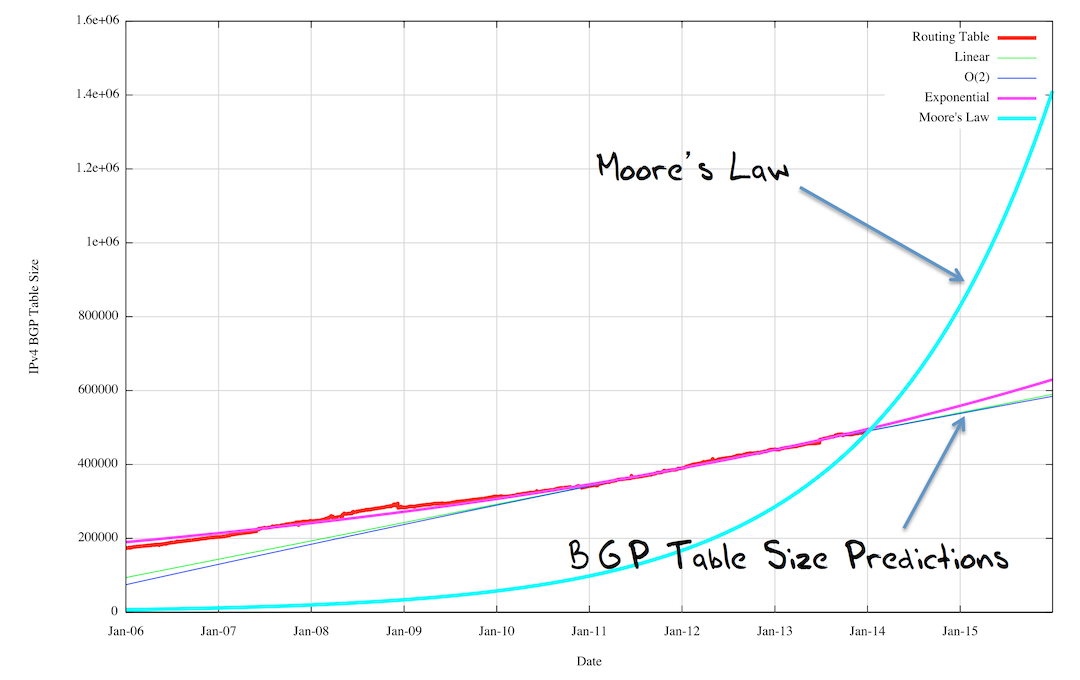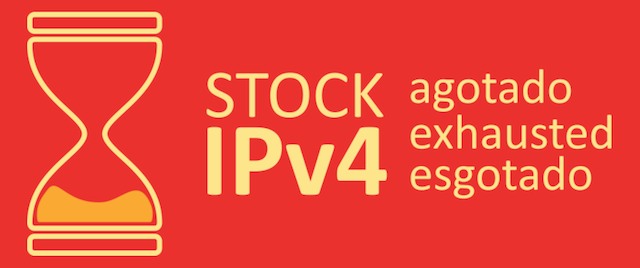►
At the February NANOG meeting, Geoff Huston talked about BGP in 2013. For a quarter of a century, there have been concerns about BGP hitting scalability issues. The Internet Architecture Board even organized a meeting to discuss the issue in 2006. However, Geoff argues that the current growth is not presenting any immediate problems: "Nothing in BGP looks like it's melting".
Full article / permalink - posted 2014-06-30
-
🇳🇱 Nederlandse versie
▼
At the February NANOG meeting, Geoff Huston talked about BGP in 2013. For a quarter of a century, there have been concerns about BGP hitting scalability issues. The Internet Architecture Board even organized a meeting to discuss the issue in 2006. However, Geoff argues that the current growth is not presenting any immediate problems: "Nothing in BGP looks like it's melting".
One of the interesting things is that the number of prefixes in BGP continues to grow at about 11% per year even though Asia and Europe were out of fresh IPv4 addresses by 2013. The number of IPv4 addresses covered by the prefixes advertised in BGP didn't grow as fast, though. Annoyingly, 50% of the half million prefixes in BGP are small address blocks (more specific prefixes) that fall within a larger address blocks (aggregates) that are also present in BGP. And the really amazing thing is that 80% of the number of daily BGP updates—which has been extremely stable for years—is caused by these more specifics.
The graph that blew my mind is this one, BGP growth vs Moore's Law:

However, that's assuming that the processing required scales linearly with the number of prefixes. That's probably (close to) true for running the BGP protocol. But that's not the hard part. The hard part is matching destination IP addresses in millions of packets per second with half a million or more prefixes in the forwarding information base (FIB) that the router hardware uses. There's pressure on FIB performance from two directions: the number of prefixes and the number of packets per second. So FIBs need to get faster and get bigger at the same time. It doesn't look like we're going to be in trouble in the immediate future, but it would still be good if we could get rid of all that unnecessary deaggregation.
Anyway, that's all IPv4. What about IPv6? Yes, it's growing. But not setting the world on fire by any stretch of the imagination. At current rates, IPv6 will reach parity with IPv4 in 2030. However, IPv6 deaggregation levels seem to be heading towards the 50% mark where IPv4 has been for some time.
Read the slides here, or download an almost 2 GB MPEG4 file of the presentation from the NANOG website. The presentation is 25 minutes and 10 minutes worth of questions and remarks from the audience, including one of the big deaggregation offenders.
Or read Addressing 2013 and especially BGP in 2013 - The Churn Report, especially if you're not completely sure about all the background and terminology.
Permalink - posted 2014-06-30
- 🇳🇱 Nederlandse versie
My Ars Technica story about ARIN and LACNIC running out of IPv4 addresses.

Permalink - posted 2014-06-12
►
If you haven't seen this TED talk, go do that first: The paradox of choice by Barry Schwartz. Schwartz is a psychologist who talks about how having more choice isn't always a
good thing.
This applies to networking, too. If you have a router connected to (say) two ISPs with BGP, for every destination on the internet, your router now has to decide whether to send packets over ISP A or ISP B. If your router consistently makes the right choice, you're better off than someone who is only connected through one ISP. But if your router consistently (or just mostly) makes the wrong choice, your performance will actually be worse than someone connected through one ISP!
Unfortunately, the BGP protocol has a very limited notion of what is best. This means that in practice, it's a good idea to not leave BGP to its own devices, but rather check whether your router(s) at the very least avoid underperforming paths. However, this can be a lot of work.
An alternative is to use a system that automatically optimizes routing performance, such as the Noction Intelligent Routing Platform
Full article / permalink - posted 2014-06-10
▼
If you haven't seen this TED talk, go do that first: The paradox of choice by Barry Schwartz. Schwartz is a psychologist who talks about how having more choice isn't always a
good thing.
This applies to networking, too. If you have a router connected to (say) two ISPs with BGP, for every destination on the internet, your router now has to decide whether to send packets over ISP A or ISP B. If your router consistently makes the right choice, you're better off than someone who is only connected through one ISP. But if your router consistently (or just mostly) makes the wrong choice, your performance will actually be worse than someone connected through one ISP!
Unfortunately, the BGP protocol has a very limited notion of what is best. This means that in practice, it's a good idea to not leave BGP to its own devices, but rather check whether your router(s) at the very least avoid underperforming paths. However, this can be a lot of work.
An alternative is to use a system that automatically optimizes routing performance, such as the Noction Intelligent Routing Platform:
Acting as a route reflector, Noction IRP can improve BGP routes, reducing packet loss and latency rates with over 40%. The platform can also proactively re-route outages and blackouts, improving the overall network performance for enterprises connected to multiple service providers. Aside its performance improvement worth, Noction IRP delivers Exquisite reporting options, enabling operations to see exactly what happens to their traffic in the internet's mid-mile.
Noction will be sponsoring this website, please check out their web page and see if the IRP fits your needs.
Permalink - posted 2014-06-10
Interesting presentation by Marc Heuse at Hack in the Box 2012: bugs in IPv6 implementations, differences between IPv4 and IPv6 filtering by large websites, discovering IPv6 systems without brute force address scanning. Did you know that on 63% of networks the ::1 address replies to pings on at least one subnet? And then the hacker security researcher knows which subnets are live.
Video at Youtube (64 minutes).
Slides.
Permalink - posted 2013-12-18
According to Olivier Bonaventure, Apple is using Multipath TCP (MPTCP) so that iOS 7 devices can communicate with the Siri servers over both Wi-Fi and 3G/LTE at the same time. If you want some background, see this article in the IETF Journal about MPTCP that I wrote in 2009.
Permalink - posted 2013-09-19
►
On Tuesday October 8, 2013, I'll be teaching the new IPv6 routing course for the first time. I'm very excited about this new training course!
Full article / permalink - posted 2013-08-20
▼
On Tuesday October 8, 2013, I'll be teaching the new IPv6 routing course for the first time. I'm very excited about this new training course!
Several times a year I teach two training courses in cooperation with NL-ix: a BGP training course and an IPv6 training course. The thing that makes our BGP training course unique is that half of it consists of the participants getting their hands dirty configuring BGP on a Cisco router. But until now, the IPv6 course was basically just me explaining IPv6 and showing a few examples.
But we now have a new, improved IPv6 training course: the IPv6 routing course. Just like the BGP course, people who participate get the chance to configure IPv6 on a Cisco router. These are the topics covered:
- IPv4 depletion
- IPv6 basics
- types of IPv6 addresses: global, link local, site local, unique site local
- RIPE policy differences between IPv4 and IPv6
- making an IPv6 addressing plan
- stateless autoconfiguration vs DHCPv6
- tunnels
- OSPF for IPv6 (OSPFv3)
- BGP for IPv6
- coexistence and interaction between IPv4 and IPv6 in BGP
- Cisco IOS:
- using ping and traceroute
- monitoring BGP status and progress
- inspecting routing tables and BGP tables
- changing next hop addresses where necessary
- enabling/disabling stateless autoconfiguration
- router advertisement flags and DHCP server or relay
The course is one day from 10 in the morning until about 4:30 in the afternoon at the NL-ix offices in The Hague. Note that the course will be in Dutch. Later this year we'll have one in English. The day before (Monday the 7th) we have our BGP course. Please see the NL-ix website for full details.
Permalink - posted 2013-08-20
older posts
- newer posts


